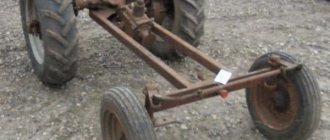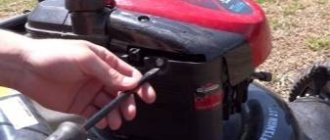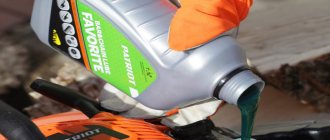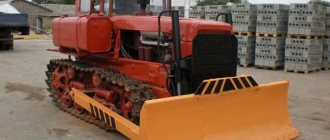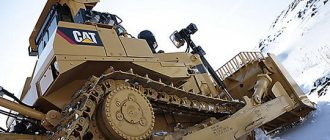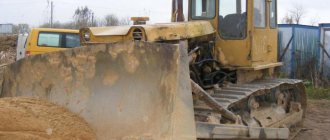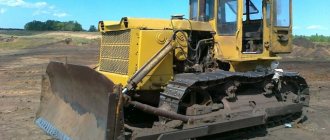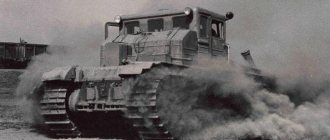Choosing the right bulldozer!
Rental of special equipment /Useful information /Choosing the right bulldozer!
Nowadays, any construction, as well as other large-scale work with soil, is difficult to imagine without heavy equipment, one of the varieties of which is a bulldozer. A bulldozer is a modified tractor equipped with a blade, that is, a shovel, which is its main working tool. Bulldozers are used for such types of work as digging trenches, moving other bulk materials on a construction site, and also as a tractor.
Bulldozers can be classified according to various indicators, for example, by the method of controlling the blade, by the type of blade itself, by the weight of the machine and its power, by the type of chassis - in most cases these are crawler bulldozers, which have increased maneuverability and the ability to move more mass and volumes of soil . But there are also wheeled tractors that, with the help of mounted bulldozer equipment, can clear the surface of light material and loosen the soil.
When choosing a bulldozer, the first thing you need to decide is the purpose of its use. Based on this, the required mass of the machine and its power are determined - in direct proportion to the volume and mass of the soil. It is also worth paying attention to the speed of movement of the bulldozer during idle and working steps - it may vary between different models and is not always directly related to power.
It is worth paying attention to the type of transmission. For example, a manual transmission is the most popular and cheapest control option. Its simplicity increases such an indicator as strength, and therefore the reliability of the structure. The hydromechanical transmission is lightweight and easy to operate, but it is more susceptible to negative environmental factors; when choosing an inexpensive bulldozer, it is better to abandon it.
The type of blade with which the bulldozer is equipped depends on the type of work, and in some cases it is possible to equip the bulldozer with various types of buckets, for example, or chain saws, etc. Dumps can be divided into three types:
- Fixed
- Turning;
- Universal;
The first is intended for the development of light types of soil, has protection at the ends in order to reduce the loss of the filled mass of material
The second is a spherical blade, which, thanks to the hinged design, allows the blade to be tilted in different directions.
The third option is also equipped with a hinge mechanism and is designed both for careful removal of the soil layer, thanks to the lower straight serrated edge, and for transporting the soil using the upper spherical part. The use of bulldozers equipped with this type of blade is quite much wider.
Additional equipment for bulldozers allows you to expand the scope of application of these machines. As an example, a bulldozer-ripper equipped with a bucket with a different number, size and arrangement of teeth depending on the type of soil.
The AvtoSpetsTrans company has a wide range of bulldozers for rent. Our specialists will help you choose a car based on your individual situation. You are guaranteed to be satisfied and not overpay.
You can rent a bulldozer in the city of St. Petersburg by phone.
Job Description for Bulldozer Driver
367 22871
We bring to your attention a typical example of a job description for a bulldozer driver, sample 2020. A person with education, special training and work experience can be appointed to this position. Don’t forget, each bulldozer operator’s instructions are handed out against a signature.
The hr-portal website provides typical information about the knowledge that a bulldozer operator must have. About duties, rights and responsibilities.
This material is included in the huge library of job descriptions on our website, which is updated daily.
General provisions
1. The bulldozer driver belongs to the category of workers.
2. A person with secondary vocational education or primary vocational education and special training is accepted for the position of Bulldozer Operator, without presenting any work experience requirements.
3. The bulldozer driver is hired and dismissed from the position of the _______ organization upon the recommendation of ________. (director, manager) (position)
4. The bulldozer operator must know:
a) special (professional) knowledge for the position:
— design, operating principle and technical characteristics of tractors and attachments.
— methods of installation and dismantling of attachments.
— causes of malfunctions and ways to eliminate them.
— rules for the development and movement of soils of various categories at different development depths.
- rules for layer-by-layer filling of embankments - rules for developing excavations, filling embankments and planning areas according to given profiles and elevations.
— instructions for use, operation, storage of devices, tools, measuring instruments and other technical means used in their work.
— sketches and drawings directly used in the process of work.
— requirements for the quality of work in related construction processes;
b) general knowledge of an employee of the organization:
— rules on labor protection, industrial sanitation and fire safety;
— rules for using personal protective equipment;
— requirements for the quality of work (services) performed and for the rational organization of labor in the workplace;
— range and labeling of materials used, consumption rates of fuels and lubricants;
— rules for moving and storing goods;
— types of defects and ways to prevent and eliminate them;
— production alarm.
5. In his activities, the bulldozer driver is guided by:
- legislation of the Russian Federation,
— Charter (regulations) of the organization,
- orders and instructions of the _______ organization (general director, director, manager)
- this job description,
— Internal labor regulations of the organization.
6. The bulldozer operator reports directly to _________ (a worker with higher qualifications, the head of production (site, workshop) and the director of the organization)
7. During the absence of the Bulldozer Driver (business trip, vacation, illness, etc.), his duties are performed by a person appointed by ________ organization (manager position) upon the recommendation of ________ (position) in the prescribed manner, who acquires the corresponding rights, duties and is responsible for the performance duties assigned to him.
Job responsibilities of a bulldozer driver
The job responsibilities of a bulldozer driver are:
a) Special (professional) job responsibilities:
— Performing work with bulldozers with engines of various power.
— Development, movement of soils and planning of areas during the construction of excavations, embankments, reserves, cavaliers and banquets during the construction of roads and railways, irrigation and shipping canals, dams, protective earthen dams, pits for buildings and structures, supports for power lines and contact networks and other similar structures.
— Carrying out emergency restoration work on railway transport.
— Performing work underwater with a bulldozer.
b) General job responsibilities of an employee of the organization:
— Compliance with the internal labor regulations and other local regulations of the organization, internal rules and regulations of labor protection, safety precautions, industrial sanitation and fire protection.
— Fulfillment, within the framework of the employment contract, of the orders of the employees to whom it was repaired in accordance with these instructions.
— Carrying out work on acceptance and delivery of shifts, cleaning and washing, disinfection of serviced equipment and communications, cleaning the workplace, fixtures, tools, as well as maintaining them in proper condition.
— Maintaining established technical documentation.
Bulldozer driver's rights
The bulldozer driver has the right:
1. Submit proposals for management’s consideration:
— to improve work related to the responsibilities provided for in this instruction,
— on bringing to material and disciplinary liability workers who violated production and labor discipline.
2. Request from structural divisions and employees of the organization the information necessary for him to perform his job duties.
3. Get acquainted with the documents defining his rights and responsibilities for his position, criteria for assessing the quality of performance of official duties.
4. Get acquainted with the draft decisions of the organization’s management relating to its activities.
5. Require the management of the organization to provide assistance, including ensuring organizational and technical conditions and execution of the established documents necessary for the performance of official duties.
6. Other rights established by current labor legislation.
Responsibility of the bulldozer operator
The bulldozer operator is responsible in the following cases:
1. For improper performance or failure to fulfill one’s job duties provided for in this job description - within the limits established by the labor legislation of the Russian Federation.
2. For offenses committed in the course of their activities - within the limits established by the current administrative, criminal and civil legislation of the Russian Federation.
3. For causing material damage to the organization - within the limits established by the current labor and civil legislation of the Russian Federation.
Job description for a bulldozer driver - sample 2020. Job responsibilities of a bulldozer driver, rights of a bulldozer driver, responsibility of a bulldozer driver.
content .. 21 22 25Ways to increase the productivity of bulldozers
Reducing the working cycle and increasing the volume of the drawing prism. The reduction in the work cycle is directly related to the increase in the speed of the machine when performing operations. The working speed usually does not exceed 3.5 km/h, and taking into account slipping of tracks or wheels - 2.8... 3.0 km/h. This is due to the fact that in the process of deepening the blade, collecting and moving the drawing prism, the driver is forced to control the position of the blade up to 20 times per cycle, replenishing the soil that spills into the side rollers. Therefore, to reduce the time of this operation, the most rational technological methods should be used.
The introduction of a blade and the formation of a soil-drawing prism in practice is carried out in the following ways.
On a horizontal surface, the blade is sharply buried in the ground to its full depth, determined by the engine load, which at the same time begins to “reduce speed.” Then the blade is gradually deepened along a stepwise trajectory until a prism is formed during the movement of the bulldozer.
When working downhill, the weight of the bulldozer increases the traction force, which makes it possible to cut the soil with uniform chips, thereby reducing the time it takes to build up the drawing prism.
Developing a face with constant small chips makes it possible to reduce soil resistance during working passes and increase movement speed. However, in this case it is possible to lengthen the path of the prism, which
will reduce the time gain to zero. Typically, the length of the soil drawing prism set is 6... 10 m.
To increase the volume of the drawing prism, the following various techniques are used.
■ The movement of the bulldozer along the same track makes it possible to form, after two or three passes, side rollers of sufficient height to limit lateral leakage of soil.
■ The trench method of soil development increases the volume of the prism, since the side walls of the trench hold the material in front of the dump. This method is often used for excavation work.
■ The paired operation of two or three bulldozers helps to increase the mass of moved soil, since spillage of soil into the side rollers between the machines is limited.
■ Working a bulldozer downhill increases the speed of movement and the volume of the prism and is advisable when working on sloping terrain or when excavating a pit.
■ Double and triple drawing prism movement improves productivity. The meaning of this method is that the prism, collected during the first pass, is moved to the middle of the working stroke. The prism collected during the second pass is brought to this place, and both prisms are moved further for some time. The same is done with the third prism and then the entire mass of soil is moved to the laying site.
■ Choosing the optimal blade cutting angle depending on the density and moisture of the soil is of great importance. When working on wet soils, it should be 45... 50°. In this case, the soil shavings rise above the dump, falling in the upper zone from the canopy, and contribute to the formation of a larger volume prism. On bulk soils, the cutting angle should be 60…65°.
■ Widers and extensions, as well as flaps installed on the sides of the blade, help to increase the drawing prism. It is advisable to use the listed additional equipment for planning work and when developing light soils and bulk stacked materials.
Automation of bulldozer operations. The automatic control system for bulldozers is used when cleaning the surface of excavation and embankment, carrying out leveling and finishing work that requires high accuracy of the level and slope of sites, etc. The productivity of leveling work of an automated bulldozer can be increased by 2...2.5 times.
The automatic control diagram of a bulldozer is shown in Fig. 24. The system consists of a control panel 1 installed in the cabin 2, blade position converters - angular 4, mounted on the push bar, and transverse 7, installed on the blade, photoreceiver 5 with a movement mechanism 6, hydraulic valves 3, laser emitter 8 and battery batteries
Rice. 24. Scheme of automatic control of a bulldozer: 1 - control panel; 2 — cabin; 3 - hydraulic valves; 4.7 - converters; 5 — photodetector device (PDU); 6 — mechanism for moving the FPU; 8 — laser emitter; 9 - battery
The system acts on the hydraulic cylinders for raising and lowering and tilting the blade when the blade deviates from the specified position. In copier mode, the machine is controlled by a laser beam emanating from emitter 8.
The laser emitter consists of a laser tube, a collimator (a device for forming a narrow beam), a prism with an electric motor for its rotation, a level and screws for installing the device in a horizontal position. Due to the rotation of the prism, the emitter sends circular signals. The radius of the emitter is 5... 500 m, and the beam width is 25... 80 mm.
Automatic control in the copy mode is achieved by the fact that the laser emitter creates a spatially stabilized reference optical plane with a specified slope. The photodetector device controls the position of the blade relative to the optical plane. When the photodetector is displaced from the optical plane in the bulldozer hydraulic system, a command is sent to the corresponding hydraulic distributor to turn on the hydraulic cylinder for raising and lowering the blade. Hydraulic cylinders always move the blade in such a way that the photodetector does not leave the optical plane. Under these conditions, the cutting edge of the blade copies, with a certain accuracy, the reference optical plane on the soil surface processed by the bulldozer.
The automatic mode of operation is usually carried out with thin cut soil chips. Therefore, to reduce the total amount of work, it is advisable to turn on the automatic mode at the final stages, having first completed a rough surface leveling with manual control of the machine.
Bulldozers DZ-171.5.0.5 are equipped with a similar automatic control system “Kombiplan-lOJI”.
content .. 21 22 25
6.2. CONTROL OF BULLDOZER T-170
Change gears and ranges when the Bulldozer comes to a complete stop. When changing gears in transport mode, stop the brake with the clutch pedal simultaneously with braking the Bulldozer with the brakes.
When changing gears, do not move both gear levers to neutral at the same time.
ATTENTION! To avoid gearbox failure, do not operate the Bulldozer when the oil pressure in the transmission lubrication system is below 50 to 70 kPa (0.55 to 0.7 kgf/cm2), in this case with the diesel engine running and the clutch on the instrument panel engaged. The emergency pressure light (ruby colored) lights up.
To check the serviceability of the pressure sensor and the warning light, after starting the diesel engine, turn off the clutch, and the emergency pressure light should light up.
To turn the Bulldozer, stop one of the tracks by turning off the corresponding onboard clutch. Sharp turns, as a rule, are made only when driving in first gear. Do not keep the brakes on when they are not required.
Move the turning control lever smoothly so that the Bulldozer turns without jerking. After completing the turn, turn off the brake, and then quickly, but without jerking, engage the side clutch.
Make large radius turns without applying the brakes.
Overcome obstacles only in first gear.
To change gears when operating the Bulldozer on slopes, it is necessary to disengage the clutch, brake the Bulldozer and, releasing a little (no more than V* stroke) the clutch pedal, engage the desired gear.
The movement of the Bulldozer from the mountain, depending on the steepness of the slope, should be carried out in 1st or 2nd gear. At the same time, reduce the rotation speed of the diesel crankshaft.
When the Bulldozer moves from a mountain, the control of the onboard clutches must be reversed; To turn right, turn off the left clutch; to turn left, turn off the right clutch. In this case, do not use the brakes. When lowering and lifting the Bulldozer with a load on the trailer, do not change gears.
Driving across slopes whose steepness exceeds 20° is not allowed.
6.3. BRAKING AND STOPPING BULLDOZER T-170
To brake (slow down) tractors, disengage the clutch and brake with lever 19 (Fig. 9) or pedal 18, reduce the rotation speed of the diesel crankshaft.
It is not recommended to brake the Bulldozer without disabling the side clutches. Only in case of emergency braking, stop the Bulldozer by pressing the brake pedal or moving the lever from the neutral position back towards you.
Before stopping, the bulldozer should be placed on a horizontal platform.
To stop the Bulldozer, reduce the fuel supply by setting the fuel supply control lever to the minimum stable rotation speed.
On the Bulldozer, disengage the clutch. Set the gear and range shift levers to neutral and engage the clutch. Install the steering control lever onto the parking brake pawl.
Leave the fuel tank valve open to prevent air from entering the fuel system.
Tips for the bulldozer operator
| 06-12-2011 |
Tips for working with a bulldozer
In this article we will look at ways to save fuel while maximizing machine performance.
A bulldozer is used primarily for loosening and clearing (leveling) earth and other materials.
Productivity and fuel consumption are highly dependent on factors such as the geography of the work site, including the flatness or sloping of the surface, as well as the consistency of the material. Also, since the bulldozer operates primarily at maximum power and due to its own weight, it is quite difficult to save on fuel when working with it. However, there are a few simple tricks that will allow you to optimize performance while reducing fuel consumption.
1. Avoid running at high idle speeds and turn off the engine
If you are waiting for a truck to arrive, for example, you can reduce fuel consumption by keeping an eye on the engine: it should not be running at high idle speeds. To reduce engine speed, use the vehicle's low power mode option or press the brake pedal.
If for one reason or another there are long intervals between passes of the bulldozer, then you should completely turn off the engine during this time.
2. Start working from the front of the treatment area
The most effective way to level material on a level surface is to shorten the distance over which the machine is under maximum load, i.e., the pass should be made from the front of the area to the back. This method allows you to increase the full load on the blade with each pass, plus productivity increases by maintaining an even ground level.
Conversely, when leveling again in the opposite direction, the pushing distance increases. In this case, it is necessary to additionally control the blade (raise/lower it) in order to prevent the tracks from slipping. Consequently, the leveled soil easily becomes uneven, making it difficult to maintain a full blade load.
3. On slopes, leveling should be done from top to bottom
If possible, when working on a slope, level the material from top to bottom: this will allow you to significantly increase work productivity and fuel efficiency (productivity per liter), since gravity will significantly help the machine.
Compared to leveling on a level surface, working in top-to-bottom passes will allow you to dig and move significantly more material. The time it takes to complete each pass is also reduced, which has a positive effect on overall work productivity.
Screeding on a slope from top to bottom also uses the weight of the machine itself, which also helps increase productivity. This is especially noticeable when working with large-sized dumps (for example, spherical dumps).
Also, climbing a slope with an angle of 7° in the second reverse gear (R2) can significantly reduce fuel consumption compared to traveling in the first reverse gear (R1). Although driving in reverse first gear uses less fuel, the dozer can travel approximately 20% further in reverse second gear using the same amount of fuel.
As a rule, when leveling material from bottom to top, productivity is always much lower, since you are working against gravity. However, this does not mean that fuel consumption will increase significantly in this case, just that each trip up the slope will take longer.
4. Other important factors
A. Avoid wheel spin and engine stall
Operating a bulldozer with slipping wheels or stalled torque converter flow leads to increased fuel consumption and causes uneven wear of the chassis.
B. Re-level material in areas where it is difficult to achieve full blade load.
In areas where it is difficult to completely fill the dump with material due to hard ground or when working with rock, re-grading in the opposite direction after the first pass will allow you to completely fill the dump with material.
C. Try to minimize spillage of material from the dump
You can increase productivity by minimizing material spillage from the dump when screeding. One effective way to do this is the method of cutting a trench with a blade.
This method is especially useful in areas where material is prone to spilling over the edge of the dump due to large volumes of soft soil or downhill movement, or in areas where large quantities of material must be moved over long distances.
The depth of the trench cut by the blade should not exceed its height. The space between such trenches should be approximately half the width of the dump.
See also: ZIL 133gya truck crane.
Return to list of articles
Bulldozers are used to develop and move soil over a distance of 50–100 m.
Cutting the vegetation layer of soil should be carried out only with bulldozers, the power of which is selected depending on the maximum depth of soil cutting. With a cutting depth of up to 15 cm, a bulldozer with a power of 80 hp is used, with a cutting depth of up to 20 cm – 100 hp, with a cutting depth of up to 30 cm – 120 and 180 hp. and when cutting over 30 cm - 250 hp. Vegetable soil cut by bulldozers can be moved to the stacks at a distance of no more than 100 m. The soil is cut by longitudinal penetrations of the bulldozer moving downhill in the working position.
When designing the site layout, it is necessary to select a soil cutting scheme, a machine movement scheme, and establish a sequence for developing sections.
If necessary, soil III gr. pre-loosened using trailed tractor rippers or trailed tractor plows.
The bulldozer excavates excavations and fills embankments in layers.
It is recommended to cut the soil using wedge-shaped chips. Bulldozers with openers on dumps, when developing the soil, cover the cutting strips by 3 - 5% of the length of the dump. In the absence of openings, reduction of soil losses is achieved by the trench method of development (Fig. 14) or by paired operation of bulldozers. Development of soil downhill (up to 20%) increases the productivity of bulldozers, and uphill development reduces it.

Rice. 14. Scheme of soil development using a bulldozer using trench and layer-by-layer methods
The movement of the bulldozer is usually carried out using the shuttle method while idling in reverse. At low reverse speeds and significant soil movement distances, the bulldozer can move in an ellipse or figure eight with two turns.
It is recommended to develop excavations using a bulldozer using a tiered - trench pattern. The tier is divided longitudinally into strips with a width equal to the length of the bulldozer blade, and walls 40–100 cm wide are left between them, thereby eliminating the loss of soil from the blade blade when moving it along the trench. The height of the tier is 40–50 cm. Soil development begins with strips adjacent to the edges of the excavation. The walls left between the trenches are developed after sampling the soil in all trenches of the first tier.
The main schemes for moving soil from a excavation to an embankment are the trench scheme without or with the formation of an intermediate shaft of soil. The first scheme is used when moving soil at a distance of 25 - 50 m, the second - at distances over 50 m.
The volume of soil (in a dense body) cut by a bulldozer blade
(m3), will be equal to:
V g
= , (25)
where a –
blade length, m;
H0–
dump height, m;
f –
angle of natural repose of the soil, degrees;
kp–
coefficient of initial soil loosening./Table 4/
When cutting soil, the length of the climb path is equal to:
Lн= , (26)
where H
– length of chips cut by a bulldozer knife (taken on average 0.2 m).
Embankments are erected using bulldozers alternately on two adjacent sections: on one of them, the layer is filled with leveling of the soil with a bulldozer, and on the other, the soil is compacted with machines.
It is advisable to carry out cleanup work using a bulldozer in combination with an excavator. In this case, the bulldozer delivers the excavated soil under the excavator bucket, from where it is fed into dump trucks or into dump trucks.
It is recommended to fill trenches or foundation cavities with transverse penetrations of a bulldozer with a fixed blade or longitudinal penetrations of a universal bulldozer. The work of the bulldozer must be combined with layer-by-layer soil compaction in the sinuses and trenches.
If the soil is mixed at a distance of up to 70 m , the bulldozer returns to the face in reverse without turning, over 70 m - in forward motion, i.e. with a turn.
Soils III and higher , as well as frozen soils of all categories, must be loosened before being developed by bulldozers. At the same time, the volume of loosened soil should not exceed the shifting capacity of a set of machines in order to avoid freezing and drying out of the soil in dry times and waterlogging in rainy weather. Dense, gravelly and crushed stone soils should be developed with bulldozers equipped with blades with teeth on knives.
Table 22.
Productivity of bulldozers when developing and moving non-rocky soil of group I with bulldozers, m3/cm.
| Tractor type | Bulldozer brand | Soil movement range, m. | |||
| DT-54 | D-159B | — | — | — | — |
| T-74 | D-535 | — | — | — | |
| S-80 | D-157 | — | |||
| S-80 | D-259 | — | |||
| S-100 | D-271 | — | |||
| S-100 | D-493 | — | |||
| T-180 | D-575A | ||||
| T-180 | D-522 | ||||
| T-180 | D-521 | ||||
| DET-250 | D-384 D-385 |
Note: the greatest efficiency is achieved when moving soil over the following distances: for bulldozers on T-74 and DT-54 tractors – 25-40 m; S-80 and S-100 – 40-60 m; T-180 and DET-250 – 70-100m.
TECHNICAL CHARACTERISTICS OF BULLDOZERS
/ENiR collection 2, §E2-1-22, table 1/
| Bulldozer brand | ||||||||
| Indicator name | DZ-29 (D-535) | DZ-42 (D-606) | DZ-8 (D-271-A) | DZ-19 (D-494A) | DZ-17 (D-492A) | DZ-18 (D-493A) | DZ-53 (D-686) | DZ-54S (D-687S) |
| Blade type | Fixed | Turning | Fixed | |||||
| Blade length, m | 2,56 | 2,56 | 3,03 | 3,03 | 3,94 | 3,97 | 3,2 | 3,2 |
| Blade height, m | 0,8 | 0,81 | 1,1 | 1,3 | 1,2 | 1,2 | ||
| Control | Hydraulic | Ropeway | Hydraulic | Ropeway | Hydraulic | Ropeway | Hydraulic | |
| Power, kW (hp) | 55 (75) | 79 (108) | ||||||
| Tractor brand | T-74 | DT-75 | T-100 | |||||
| Weight of bulldozer equipment, t | 0,85 | 1,07 | 1,58 | 1,53 | 2,22 | 1,86 | 2,13 | 1,78 |
Continuation of Table 1
| Bulldozer brand | ||||||||
| Indicator name | D-259 | DZ-101 | DZ-104 | DZ-27S (D-532S) | DZ-110 DZ-110A | DZ-28 (D-533) | DZ-109, DZ-109B | DZ-9 (D-275A) |
| Blade type | Turning | Fixed | Turning | Fixed | Turning | Fixed | ||
| Blade length, m | 4,15 | 2,86 | 3,28 | 3,2 | 3,2 | 3,94 | 4,12 | 3,35 |
| Blade height, m | 1,1 | 0,95 | 0,99 | 1,3 | 1,3 | 1,14 | 1,1 | |
| Control | Ropeway | Hydraulic | Ropeway | |||||
| Power, kW (hp) | 79 (108) | 96 (130) | 118 (160) | 118 (160) | 132 (180) | |||
| Tractor brand | T-100 | T4-AP1 | T-130 | T-130 | T-180 | |||
| Weight of bulldozer equipment, t | 2,27 | 1,44 | 1,77 | 1,91 | 2,28 | 2,85 | 2,64 | 2,56 |
Continuation of Table 1
| Bulldozer brand | |||||||||
| Indicator name | DZ-24 (D-521) | DZ-35S (D-575S) | DZ-24A (D-521A) | DZ-25 (D-522) | D-290 | D-384 | D-385 | DZ-34S (D-572S) | DZ-118 |
| Blade type | Fixed | Turning | Fixed | Turning | Fixed | ||||
| Blade length, m | 3,36 | 3,64 | 3,64 | 4,43 | 4,59 | 4,5 | 4,53 | 4,54 | 4,31 |
| Blade height, m | 1,1 | 1,29 | 1,43 | 1,2 | 1,27 | 1,4 | 1,4 | 1,55 | 1,55 |
| Control | Hydraulic | Ropeway | Hydraulic | Ropeway | Hydraulic | ||||
| Power, kW (hp) | 132 (180) | 221 (300) — 228 (310) | 250 (340) | ||||||
| Tractor brand | T-180 | DET-250 | DET-250M | ||||||
| Weight of bulldozer equipment, t | 1,96 | 3,4 | 2,86 | 2,85 | 3,51 | 2,8 | 4,5 | 3,98 | 4,8 |
